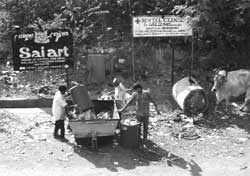Collection
 The household waste is disposed of either via a door-to-door collection system, which is not so common, or in municipal facilities. Excluding posh residential and commercial colonies, most of the households, shops and other establishments throw waste as and when it is generated.
The household waste is disposed of either via a door-to-door collection system, which is not so common, or in municipal facilities. Excluding posh residential and commercial colonies, most of the households, shops and other establishments throw waste as and when it is generated.
At some places, where bins have been provided, the bins are placed at great distances and bin sizes are small. The number of bins is also very little. According to the Interim Report for the Supreme Court, there is one bin for 130 persons, and this goes up to 2,389 in some places. The distance between the household and the dustbin varies between 50 to 500 metres.
Besides, the design of the bins is also found to be inappropriate. The Municipal Corporation of Delhi (mcd), which is responsible for the civic services in the city, uses receptacles called dhalao and dustbins for storage of wastes. The dhalao is a room-like structure with an opening, while dustbin is a rectangular structure, with an iron mesh on the top.
A cpcb survey reported that of the 984 receptacles, 370 were either dilapidated or not being properly managed, while 426 of them had garbage spilling over. It also made an observation that the unhygenic conditions compelled people to throw the waste from a distance. Malik speaks of her personal experience: "I used to take my son with me to throw the garbage in the municipality bin in our area. But the bin used to be so dirty that it was impossible for anyone to go there and deposit the garbage. People used to just aim their garbage and let fly. Most of the time, they missed.'
Street sweeping is another common method of collection of municipal wastes, especially since most of the waste is disposed off on the streets. However, the Interim Report notes, "Certain important roads and markets are swept daily; some are swept on alternate days, twice a week or once a week depending on the concentration of population/activity...'
The road length for which a sweeper is responsible is also not standardised. At some places, it is on the basis of square metres (sq m), ranging from 3,000 to 10,000 sq m, and at some places it is on a population basis
Related Content
- Counter affidavit on behalf of Chief Municipal Engineer, Patna Nagar Nigam on solid waste management and sanitation in Patna, 20/05/2025
- Order of the National Green Tribunal regarding remedial actions to be taken for abatement of pollution of river Bhadar near Ahmedabad, Gujarat, 09/05/2025
- Affidavit by Ministry of Environment, Forest and Climate Change (MoEFCC) on the declining forest cover in northeastern states, 08/05/2025
- Order of the National Green Tribunal regarding construction of a sewer line along a 600-metre stretch of the Yelahanka Puttenahalli Lake Bird Conservation Reserve, Bengaluru, Karnataka, 02/05/2025
- Order of the National Green Tribunal regarding rising pollution in the Vishaw stream, a tributary of the river Jhelum due to illegal mining, Jammu & Kashmir, 23/04/2025
- Compliance affidavit by Tahasildar, Jaleswar, District Balasore regarding sand walls being erected in Subarnarekha, Balasore, Odisha, 22/04/2025
